Nonlinear Maps Preserving the Jordan Triple∗-Product on Factor von Neumann Algebras∗
Changjing LI Quanyuan CHEN Ting WANG
Abstract Let A and B be two factor von Neumann algebras.For A,B∈A,define by[A,B]∗=AB −BA∗the skew Lie product of A and B.In this article,it is proved that a bijective map Φ :A → B satisfies Φ([[A,B]∗,C]∗)=[[Φ(A),Φ(B)]∗,Φ(C)]∗ for all A,B,C ∈ A if and only if Φ is a linear ∗-isomorphism,or a conjugate linear ∗-isomorphism,or the negative of a linear∗-isomorphism,or the negative of a conjugate linear∗-isomorphism.
Keywords Jordan triple∗-product,Isomorphism,von Neumann algebras
1 Introduction
Let A be a ∗-algebra and η be a non-zero scalar.For A,B ∈ A,define the Jordan η-∗-product of A and B by A♦ηB=AB+ ηBA∗.The Jordan(−1)-∗-product,which is customarily called the skew Lie product,was extensively studied because it naturally arises in the problem of representing quadratic functionals with sesquilinear functionals(see[9–11])and in the problem of characterizing ideals(see[2,8]).We often write the Jordan(−1)-∗-product by[A,B]∗,that is[A,B]∗=AB −BA∗.A not necessarily linear map Φ between ∗-algebras A and B is said to preserve the Jordan η-∗-product if Φ(A♦ηB)= Φ(A)♦ηΦ(B)for all A,B ∈ A.Recently,many authors have started to pay more attention to the maps preserving the Jordan η-∗-product between ∗-algebras(see[1,3,6–7]).In[3],Dai and Lu proved that if Φ is a bijective map preserving the Jordan η-∗-product between two von Neumann algebras,one of which has no central abelian projections,then Φ is a linear ∗-isomorphism if η is not real and Φ is a sum of a linear ∗-isomorphism and a conjugate linear ∗-isomorphism if η is real.
Recently,Huo et al.[5]studied a more general problem.They considered the Jordan triple η-∗-product of three elements A,B and C in a ∗-algebra A defined by A♦ηB♦ηC=(A♦ηB)♦ηC(we should be aware that♦ηis not necessarily associative).A map Φ between ∗-algebras A and B is said to preserve the Jordan triple η-∗-product if Φ(A♦ηB♦ηC)= Φ(A)♦ηΦ(B)♦ηΦ(C)for all A,B,C ∈ A.Clearly a map between ∗-algebras preserving the Jordan η-∗-product also preserves the Jordan triple η-∗-product.However,the map Φ :C → C,Φ(α+βi)= −4(α3+β3i)is a bijection which preserves the Jordan triple(−1)-∗-product and Jordan triple 1-∗-product,but it does not preserve the Jordan(−1)-∗-product or Jordan 1-∗-product.So,the class of those maps preserving the Jordan triple η-∗-product is,in principle wider than the class of maps preserving the Jordan η-∗-product.
In[5],let η 6= −1 be a non-zero complex number,and let Φ be a bijection between two von Neumann algebras,one of which has no central abelian projections,satisfying Φ(I)=I and preserving the Jordan triple η-∗-product.Huo et al.showed that Φ is a linear ∗-isomorphism if η is not real and Φ is the sum of a linear ∗-isomorphism and a conjugate linear ∗-isomorphism if η is real.On the one hand,Huo et al.did not consider the case η = −1.However,the Jordan(triple)(−1)-∗-product is the most meaningful and important in Jordan(triple) η-∗-products.On the other hand,it is easy to see that a map Φ preserving the Jordan triple η-∗-product does not need to satisfy Φ(I)=I.Indeed,let Φ(A)= −A for all A ∈ A.Then Φ preserves the Jordan triple η-∗-product but Φ(I)= −I.Because of the above two reasons,in this paper,we will discuss maps preserving the Jordan triple(−1)-∗-product without the assumption Φ(I)=I.We mainly prove that a bijective map Φ between two factor von Neumann algebras preserves the Jordan triple(−1)-∗-product if and only if Φ is a linear ∗-isomorphism,or a conjugate linear∗-isomorphism,or the negative of a linear ∗-isomorphism,or the negative of a conjugate linear∗-isomorphism.
As usual,R and C denote respectively the real field and complex field.Throughout,algebras and spaces are over C.A von Neumann algebra A is a weakly closed,self-adjoint algebra of operators on a Hilbert space H containing the identity operator I.A is a factor von Neumann algebra means that its center contains only the scalar operators.It is clear that if A is a factor von Neumann algebra,then A is prime,that is,for A,B∈A if AAB={0},then A=0 or B=0.
2 The Main Result and Its Proof
To complete the proof of main theorem,we need two lemmas.
Lemma 2.1 Let A be an arbitrary factor von Neumann algebra with the identity operator I and A∈A.If AB=BA∗for all B∈A,then A∈RI.
Proof In fact,take B=I,then A=A∗.So AB=BA for all B ∈ A,which implies A belongs to the center of A.Note that A is a factor,it follows that A∈RI.
Lemma 2.2(see[4,Problem 230]) Let A be a Banach algebra with the identity I.If A,B ∈ A and λ ∈ C are such that[A,B]= λI,where[A,B]=AB −BA,then λ =0.
The main result in this paper is as follows.
Theorem 2.1 Let A and B be two factor von Neumann algebras.Then a bijective map Φ :A → B satisfies Φ([[A,B]∗,C]∗)=[[Φ(A),Φ(B)]∗,Φ(C)]∗for all A,B,C ∈ A if and only if Φ is a linear∗-isomorphism,or a conjugate linear∗-isomorphism,or the negative of a linear∗-isomorphism,or the negative of a conjugate linear ∗-isomorphism.
Proof Clearly,we only need to prove the necessity.First we give a key technique.Suppose that A1,A2,···,Anand T are in A such thatThen for all S1,S2∈A,we have

and

In the following,we will complete the proof of Theorem 2.1 by proving several claims.
Claim 1 Φ(0)=0.
Since Φ is surjective,there exists A ∈ A such that Φ(A)=0.Then we obtain Φ(0)=Φ([[0,A]∗,A]∗)=[[Φ(0),Φ(A)]∗,Φ(A)]∗=0.
Claim 2 Φ(RI)=RI, Φ(CI)=CI and Φ preserves self-adjoint elements in both directions.
Let λ ∈ R be arbitrary.Since Φ is surjective,there exists B ∈ A such that Φ(B)=I.By Claim 1,we have that

holds true for all A∈A.That is,

holds true for all A∈A.So

holds true for all B=B∗∈B.Since for every B ∈B,B=B1+iB2withandit follows that

holds true for all B ∈ B.It follows from Lemma 2.1 that Φ(λI) ∈ RI.Note that Φ−1has the same properties as Φ.Similarly,if Φ(A)∈ RI,then A ∈ RI.Therefore,Φ(RI)=RI.
Let A=A∗∈ A.Since Φ(RI)=RI,there exists λ ∈ R such that Φ(λI)=I.Then

Hence Φ(A)= Φ(A)∗.Similarly,if Φ(A)= Φ(A)∗,then A=A∗∈ A.Therefore Φ preserves self-adjoint elements in both directions.
Let λ ∈ C be arbitrary.For every A=A∗∈ A,we obtain that

holds true for all C∈A.It follows from Lemma 2.1 that

Since A=A∗,we have Φ(A)= Φ(A)∗.Hence

It follows from Lemma 2.2 that

and then

for all B=B∗∈B.Thus for every B ∈B,since B=B1+iB2withandwe get

holds true for all B ∈ B.Hence Φ(λI)∈ CI.Similarly,if Φ(A)∈ CI,then A ∈ CI.Therefore,Φ(CI)=CI.
By Claim 2,we have

and

where α,β,γ,ω,γ1,ω1∈ R and αβγω 6=0.It follows fromthat

So γ1=0.Similarly,by the equalitywe get that ω1=0.
Now we get





Now(2.4)–(2.7)ensures that

For every A∈A,it follows from iAthat

which together with(2.8)implies that Φ(iA)=iΦ(A)(∀A ∈ A)or Φ(iA)= −iΦ(A)(∀A ∈ A).
Choose an arbitrary nontrivial projection P1∈A,and write P2=I−P1.Denote Aij=PiAPj,i,j=1,2,then.For every A∈A,we may writeIn all that follows,when we write Aij,it indicates that Aij∈ Aij.The following Claims 4–9 are devoted to the additivity of Φ.
Claim 4 For every A11∈A11and B22∈A22,we have

Since Φ is surjective,we may find an elementsuch that

Since[[iP1,I]∗,A22]∗=0,it follows from(2.1)and Claim 1 that

By the injectivity of Φ,we obtain that

and then we get T11=A11,T12=T21=0.Similarly,T22=B22,proving the claim.
Claim 5 For every A12∈A12,B21∈A21,we have


Since

it follows from(2.1)that

From this,we get[[i(P2− P1),I]∗,T]∗=0.So T11=T22=0.Since[[A12,P1]∗,I]∗=0,it follows from(2.3)that

By the injectivity of Φ,we obtain that

Hence T21=B21.Similarly,T12=A12,proving the claim.
Claim 6 For every A11∈A11,B12∈A12,C21∈A21,D22∈A22,we have

and


It follows from(2.1)and Claim 5 that

Thus P2T+TP2=B12+C21,which implies T22=0,T12=B12,T21=C21.Now we get T=T11+B12+C21.
Since

it follows from(2.1)that

from which we get T11=A11.Consequently,Φ(A11+B12+C21)=Φ(A11)+Φ(B12)+Φ(C21).
Similarly,we can get that Φ(B12+C21+D22)= Φ(B12)+Φ(C21)+Φ(D22).
Claim 7 For every A11∈A11,B12∈A12,C21∈A21,D22∈A22,we have


It follows from(2.1)and Claim 6 that

Thus

it follows that T11=A11,T12=B12,T21=C21.Similarly,we can get

From this,we get T22=D22,proving the claim.
Claim 8 For every Ajk,Bjk∈Ajk,1≤j 6=k≤2,we have

Since

we get from Claim 7 that

which implies Φ(i(Ajk+Bjk))= Φ(iBjk)+Φ(iAjk).By Claim 3,we obtain that Φ(Ajk+Bjk)=Φ(Ajk)+Φ(Bjk).
Claim 9 For every Ajj∈Ajjand Bjj∈Ajj,1≤j≤2,we have


For 1≤j 6=k≤2,it follows from(2.1)that

Hence PkT+TPk=0,which implies Tjk=Tkj=Tkk=0.Now we get T=Tjj.
For every Cjk∈Ajk,j 6=k,it follows from(2.2)and Claim 8 that

Hence

for all Cjk∈Ajk.By the primeness of A,we get that Tjj=Ajj+Bjj,proving the claim.
Claim 10 Φ is ∗-additive.
The additivity of Φ is an immediate consequence of Claims 7–9.For every A ∈ A,A=A1+iA2,whereare self-adjoint elements.By Claims 2–3,if for every A ∈ A,Φ(iA)=iΦ(A),then

Similarly,if Φ(iA)= −iΦ(A)(∀A ∈ A),we also have Φ(A∗)= Φ(A)∗.
By Claims 3 and 10,we get that Φ(I)=I or Φ(I)= −I.In the rest of this section,we deal with these two cases respectively.
Case 1 If Φ(I)=I,then Φ is either a linear ∗-isomorphism or a conjugate linear ∗-isomorphism.
If Φ(I)=I,by(2.8)–(2.9)and Claim 10,thenΦ(iI)=2ωiI and Φ(iA)=−2γiΦ(A)for all A∈A.For all A,B ∈ A,we can obtain that

From this,we get


For all A,B∈A,it follows from Claim 3 that Summing(2.10)with(2.11),we get that Φ(AB)= Φ(A)Φ(B).
For every rational number q,we have Φ(qI)=qI.Indeed,since q is a rational number,there exist two integers r and s such that q=Since Φ(I)=I and Φ is additive,we get that

Let A be a positive element in A.Then A=B2for some self-adjoint element B∈A.It follows from Claim 11 that Φ(A)= Φ(B)2.By Claim 2,we get that Φ(B)is self-adjoint.So Φ(A)is positive.This shows that Φ preserves positive elements.
Let λ∈R.Choose sequence{an}and{bn}of rational numbers such that an≤λ≤bnfor all n andIt follows from

that

Taking the limit,we get that Φ(λIA)= λIB.Hence for all A ∈ A,

Hence Φ is real linear.Therefore,if Φ(iA)=iΦ(A)(∀A ∈ A),then Φ is a linear ∗-isomorphism.If Φ(iA)= −iΦ(A)(∀A ∈ A),then Φ is a conjugate linear ∗-isomorphism.
Case 2 If Φ(I)= −I,then Φ is either the negative of a linear∗-isomorphism or the negative of a conjugate linear∗-isomorphism.
Consider that the map Ψ :A → B defined by Ψ(A)= −Φ(A)for all A ∈ A.It is easy to see that Ψ satisfies Ψ([[A,B]∗,C]∗)=[[Ψ(A),Ψ(B)]∗,Ψ(C)]∗for all A,B,C ∈ A and Ψ(I)=I.Then the arguments for Case 1 ensure that Ψ is either a linear ∗-isomorphism or a conjugate linear ∗-isomorphism.So Φ is either the negative of a linear ∗-isomorphism or the negative of a conjugate linear∗-isomorphism.
Combining Cases 1–2,the proof of Theorem 2.1 is finished.
AcknowledgementThe authors would like to thank the referee for his valuable comments and suggestions.
 Chinese Annals of Mathematics,Series B2018年4期
Chinese Annals of Mathematics,Series B2018年4期
- Chinese Annals of Mathematics,Series B的其它文章
- Hessian Comparison and Spectrum Lower Bound of Almost Hermitian Manifolds∗
- Ergodicity and First Passage Probability of Regime-Switching Geometric Brownian Motions∗
- Endpoint Estimates for Generalized Multilinear Fractional Integrals on the Non-homogeneous Metric Spaces∗
- Error Analysis on Hérmite Learning with Gradient Data∗
- A Schwarz Lemma at the Boundary of Hilbert Balls∗
- On Affine Connections Induced on the(1,1)-Tensor Bundle
